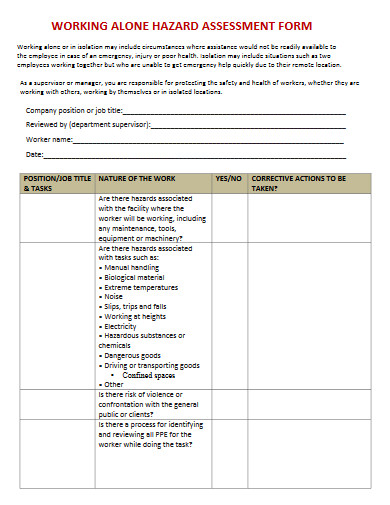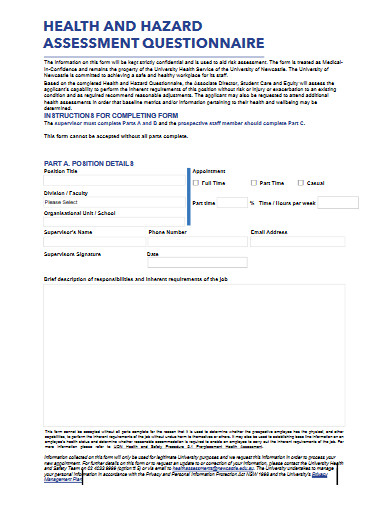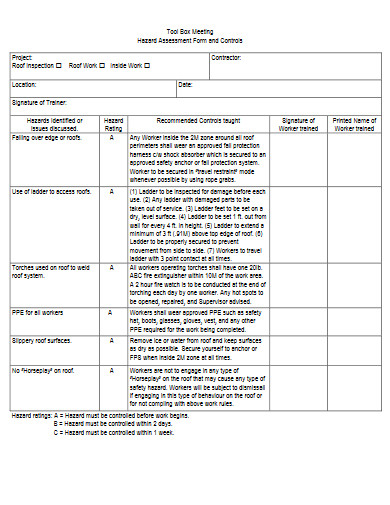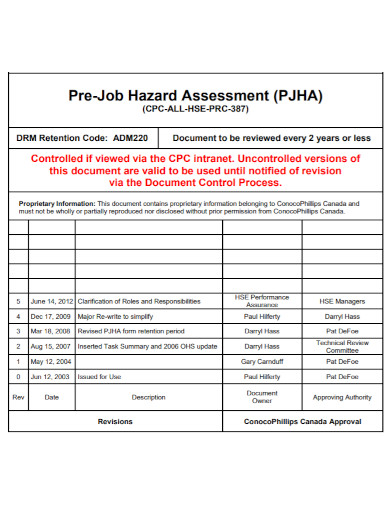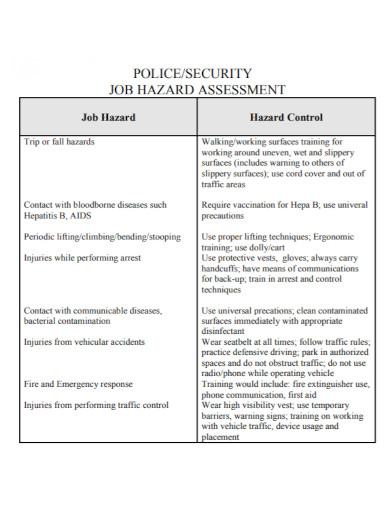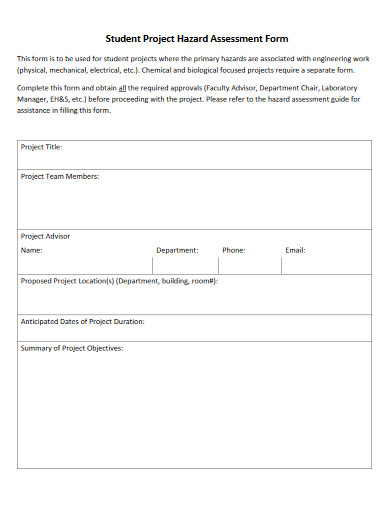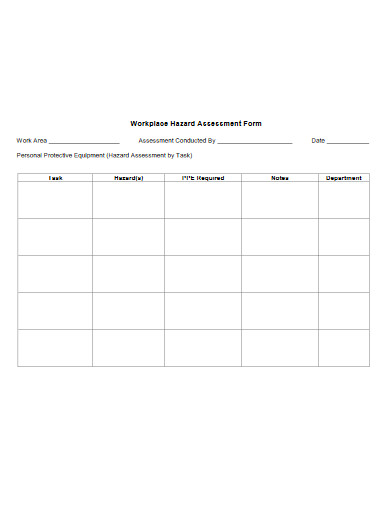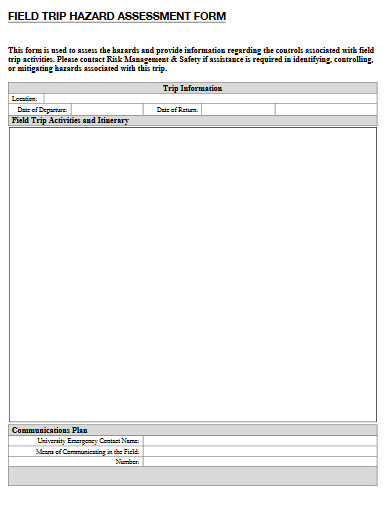10+ Hazard Assessment Examples to Download
No matter how careful or meticulous you are of avoiding any problems whether at work, in school or even at home or outside, there will always be a time that you least expect. We call them hazardous events. These types of events are something we never expect to happen but they happened anyway. Rather than having to give up and say, it happened, there is nothing we can do, there are ways of foreseeing things like these to happen. If you are wondering how on earth is that even possible, let’s take a look at the article below. 10+ hazard assessment examples.
10+ Hazard Assessment Examples
1. General Hazard Assessment Checklist Template
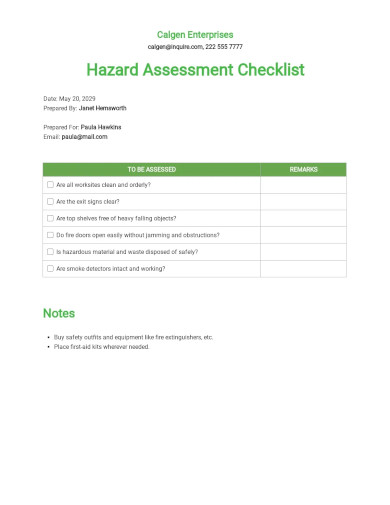
2. Fall Hazard Assessment
3. Working Alone Hazard Assessment Form
4. Hazard Assessment Questionnaire
5. Hazard Assessment Form
6. Pre-Job Hazard Assessment
7. Job Hazard Assessment in PDF
8. Security Job Hazard Assessment
9. Student Project Hazard Assessment
10. Workplace Hazard Assessment Form
11. Field Trip Hazard Assessment Form
Definition of Hazard
A hazard is a source of potential or pending harm or damage to someone or something. Hazards can come in all shapes and sizes. From injury to damage of property, environment, workplace or any combination of them. It is also an unwanted and unplanned incident where the loss of control can lead to dangerous consequences. It is also called an unavoidable or unforeseen issue or risk. Something that was not planned or sought out. Usually causing someone or something harm that can lead to dangerous consequences.
Definition of Assessment
A tool used for rigorous gathering of data, analysis and evaluation. An assessment is an examination or a series of tests that is given by the assessor. The assessor uses it to evaluate something or someone. It is the process of getting information needed to support the assessment. It is also a systematic examination that caters to help out understand the problem and to find a solution for it.
Importance of Hazard Assessment
The importance of having a hazard assessment is to figure out the potential risks and hazards. Specify them by making a list and to address them before they get worse. Hazard assessments are made to prevent problems that may result in a series of consequences. Doing the assessment also helps slowly eliminate the issues before anyone suffers from the potential hazards. Failure to do the hazard assessment can lead to a lot of problems that may not only be an issue, but would also be harder to lessen. This is especially true for businesses and companies with a lot of employees.
Tools Used for Hazard Assessment
Here are just some example tools that are commonly used for assessment. Each tool has its own use. These tools are simply just a few common examples as there are a lot more.
- Checklist
- Questionnaire
- Forms
- Narrative
- Table
- Outline
Tips for Hazard Assessment
- Gather important data – Beginning of the assessment, gather important data and information about the problem. Your data should be a part of the reason for the assessment. Any other possible data that is not related to your assessment should be discarded.
- Have an open mind when analyzing data and possible problems – The reason to have an open mind when analyzing your data is because there may be times it won’t make sense to you. But as you continue to analyze the information given, it would either get complicated or easier. Always keep an open mind.
- Justify the results of your assessment- Explain in detail as to how you got to this point of the assessment. Explain the steps taken and why you believe this is the right choice to support your claims.
- Make a record of your results– Once you are done with writing down your results, make a record of your own. This helps when you are going to have to go through another assessment that may have the same as what you are doing now. Think of extra notes for this.
- Report your answers to your superiors – Now that you have done your assessment, report it to your superiors. For them to understand the situation and offer them some advice or some steps to eliminating the problem.
FAQs
Who is at risk with the hazards?
Anyone working in any company or business. Anyone is at risk with any type of hazard. Depending on where the hazard is found, the most common people who are at risk are those who work in buildings. As this is the most common place to find a lot of dangerous hazards that often get overlooked.
How do I give my report or feedback on the assessment?
Simply state the answers, the reason why you believe this is the cause and to show them hard proof.
Why do I need to show them hard evidence when making the assessment?
The reason for this is because evidence does not lie. Also, it is always best to show them facts that support your assessment. Let your assessment and evidence tell the story.
Are assessments useful?
Yes. Assessments are useful, especially when you need to judge something or someone with enough knowledge about them or about the object.
Hazards can happen anytime and anywhere. It is also difficult to avoid them when you have no idea when and where they may happen. But there is a way to check if the place is filled with hazards and risks by doing a hazard assessment.


![10+ Hazard Assessment Examples [ Workplace, Job, Project ]](https://images.examples.com/wp-content/uploads/2021/07/10-Hazard-Assessment-Examples-Workplace-Job-Project-.jpg)

